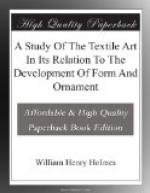Japanese art is celebrated for its exquisite decorative design. Upon superb works of porcelain we have skillful representations of subjects taken from nature and from mythology, which are set with perfect taste upon fields or within borders of elaborate geometric design. If we should ask how such motives came to be employed in ceramic decoration, the answer would be given that they were selected and employed because they were regarded as fitting and beautiful by a race of decorators whose taste is well nigh infallible. But this explanation, however satisfactory as applied to individual examples of modern art, is not at all applicable to primitive art, for the mind of man was not primarily conscious of the beauty or fitness of decorative elements, nor did he think of using them independently of the art to which they were indigenous. Now the ceramic art gives rise to comparatively few elements of decoration, and must therefore acquire the great body of its decorative motives from other arts by some process not primarily dependent upon the exercise of judgment or taste, and yet not by direct inheritance, as the techniques of the two arts are wholly distinct.
Textile and fictile arts are, in their earlier stages, to a large extent, vessel making arts, the one being functionally the offshoot of the other. The textile art is the parent, and, as I have already shown, develops within itself a geometric system of ornament. The fictile art is the offshoot and has within itself no predilection for decoration. It is dependent and plastic. Its forms are to a great extent modeled and molded within the textile shapes and acquire automatically some of the decorative surface characters of the mold. This is the beginning of the transfer, and as time goes on other methods are suggested by which elements indigenous to the one art are transferred to the other. Thus we explain the occurrence, the constant recurrence of certain primary decorative motives in primitive ceramics. The herring bone, the checker, the guilloche, and the like are greatly the heritage of the textile art. Two forms derived from textile surfaces are illustrated in Figs. 351 and 352. In the first example shown, herring bone patterns appear as the result of textile combination, and in the second a triangular checker is produced in the same way. In Fig. 352 we see the result of copying these patterns in incised lines upon soft clay.
[Illustration: FIG. 351. Herring bone and checker patterns produced in textile combinations.]
[Illustration: FIG. 352. Herring bone and checker figures in fictile forms transferred from the textile.]




